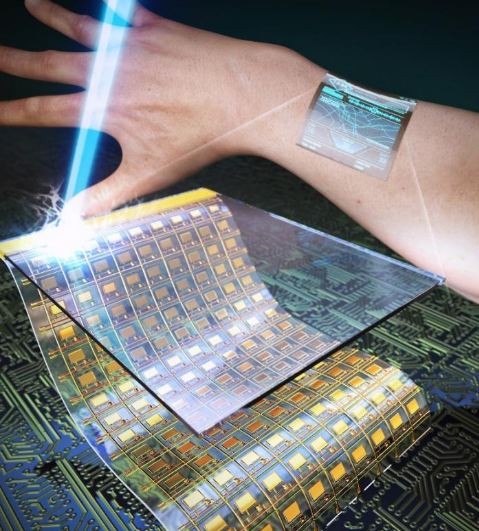South Korean Scientists Develop Ultrathin, Transparent Oxide Thin-film Transistors for Wearable Displays
| Arthur Dominic Villasanta | | Jul 30, 2016 11:48 PM EDT |
(Photo : Korea Advanced Institute of Science and Technology (KAIST)) This image shows ultrathin, flexible, and transparent oxide thin-film transistors produced via the ILLO process.
South Korean researchers at the Department of Materials Science and Engineering at the Korea Advanced Institute of Science and Technology (KAIST) have developed ultrathin and transparent oxide thin-film transistors (TFT) for an active-matrix backplane of a flexible display by using the inorganic-based laser lift-off (ILLO) method.
Like Us on Facebook
The team led by Professors Keon Jae Lee and Sang-Hee Ko Park of KAIST previously demonstrated the ILLO technology for energy-harvesting and flexible memory devices.
They fabricated a high-performance oxide TFT array on top of a sacrificial laser-reactive substrate. After laser irradiation from the backside of the substrate, only the oxide TFT arrays were separated from the sacrificial substrate as a result of reaction between laser and laser-reactive layer, and then subsequently transferred onto ultrathin plastics (4μm thickness).
Finally, the transferred ultrathin-oxide driving circuit for the flexible display was attached conformally to the surface of human skin to demonstrate the possibility of the wearable application. The attached oxide TFTs showed high optical transparency of 83% and mobility of 40 cm^2 V^(-1) s^(-1) even under several cycles of severe bending tests.
"By using our ILLO process, the technological barriers for high performance transparent flexible displays have been overcome at a relatively low cost by removing expensive polyimide substrates," said Professor Lee.
"Moreover, the high-quality oxide semiconductor can be easily transferred onto skin-like or any flexible substrate for wearable application."
The advent of the Internet of Things (IoT) has seen strong demand for wearable and transparent displays that can be applied to various fields such as augmented reality (AR) and skin-like thin flexible devices.
Previous flexible transparent displays, however, have posed tough challenges difficult to overcome. Among these are poor transparency and low electrical performance.
To improve the transparency and performance, past research efforts have used inorganic-based electronics, but the fundamental thermal instabilities of plastic substrates have hampered the high temperature process, an essential step necessary for the fabrication of high performance electronic devices.
TagsKorea Advanced Institute of Science and Technology, KAIST, inorganic-based laser lift-off (ILLO) method, Keon Jae Lee, Sang-Hee Ko Park
©2015 Chinatopix All rights reserved. Do not reproduce without permission
EDITOR'S PICKS
-

Did the Trump administration just announce plans for a trade war with ‘hostile’ China and Russia?
-

US Senate passes Taiwan travel bill slammed by China
-

As Yan Sihong’s family grieves, here are other Chinese students who went missing abroad. Some have never been found
-

Beijing blasts Western critics who ‘smear China’ with the term sharp power
-

China Envoy Seeks to Defuse Tensions With U.S. as a Trade War Brews
-

Singapore's Deputy PM Provides Bitcoin Vote of Confidence Amid China's Blanket Bans
-

China warns investors over risks in overseas virtual currency trading
-

Chinese government most trustworthy: survey
-

Kashima Antlers On Course For Back-To-Back Titles
MOST POPULAR
LATEST NEWS
Zhou Yongkang: China's Former Security Chief Sentenced to Life in Prison

China's former Chief of the Ministry of Public Security, Zhou Yongkang, has been given a life sentence after he was found guilty of abusing his office, bribery and deliberately ... Full Article
TRENDING STORY

China Pork Prices Expected to Stabilize As The Supplies Recover

Elephone P9000 Smartphone is now on Sale on Amazon India

There's a Big Chance Cliffhangers Won't Still Be Resolved When Grey's Anatomy Season 13 Returns

Supreme Court Ruled on Samsung vs Apple Dispute for Patent Infringement

Microsoft Surface Pro 5 Rumors and Release Date: What is the Latest?














